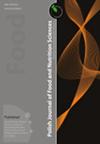Effects of Long-Term Dietary Administration of Kale (Brassica oleracea L. var. acephala DC) Leaves on the Antioxidant Status and Blood Biochemical Markers in Rats
IF 2.3
4区 农林科学
Q3 FOOD SCIENCE & TECHNOLOGY
引用次数: 0
Abstract
Kale ( Brassica oleracea L. var. acephala DC) is a leafy green vegetable which belongs to the Brassicaceae family, one of the most commonly culti - vated and consumed edible plants. The aim of this study was to investigate the potential adverse effects and antioxidant properties of freeze-dried kale leaves in 90-day dietary experiment on Wistar rats. The kale leaf powder was added to a diet at levels: 10, 30, and 60 g/kg feed. The standard blood biochemical and hematological markers, antioxidant enzyme activities, level of lipid peroxidation, reduced glutathione content, and damage to DNA in the liver were measured. Antioxidant potential in serum was measured and expressed as Trolox equivalents antioxidant capacity (TEAC). The kale leaf phytochemicals, i.e. , glucosinolates, phenolic acids and flavonols, were quantified. Major glucosinolates were glucoiberin (164.6 mg/100 g d.w.) and glucobrassicin (130.6 mg/100 g d.w.), whereas kaempferol (159.1 mg/100 g d.w.), quercetin (119.6 mg/100 g d.w.), and sinapic acid (73.8 mg/100 g d.w.) dominated among phenolics. The lowest dose of kale leaves augmented the activity of catalase by 34% in males and by 44% in females. The high est applied dose increased activities of glutathione reductase by 31%, superoxide dismutase by 27%, and glutathione S -transferase by 24% in males only. Kale administration did not affect the activities of glutathione peroxidase and paraoxonase 1, glutathione concentration, lipid peroxidation level, and the level of DNA damage in the liver and the whole blood leukocytes. TEAC increased upon all doses of kale leaves by 30–90% in males and by 40–90% in females. The diet with kale did not affect blood biochemical and hematological markers. Results confirm no adverse effects of dried kale leaves used in model rat’s diet up to 60 g/kg for 90 days. The changes in hepatic antioxidant enzymes and plasma TEAC suggest beneficial effect of kale leaves on the antioxidant status in rats. Interestingly, these changes were more pronounced in male versus female animals.甘蓝(Brassica oleracea L.var.acephala DC)叶片长期日粮对大鼠抗氧化状态和血液生化指标的影响
甘蓝(Brassica oleracea L. var. acephala DC)是一种绿叶蔬菜,属于芸苔科,是最常种植和消费的食用植物之一。本研究通过对Wistar大鼠进行90 d的饮食试验,探讨冻干羽衣甘蓝叶的潜在不良反应和抗氧化性能。在饲粮中按10、30和60 g/kg添加羽衣甘蓝叶粉。测定标准血液生化和血液学指标、抗氧化酶活性、脂质过氧化水平、还原性谷胱甘肽含量和肝脏DNA损伤。测定血清抗氧化潜能,并用Trolox当量抗氧化能力(TEAC)表示。对羽衣甘蓝叶片中的硫代葡萄糖苷、酚酸和黄酮醇等植物化学物质进行了定量分析。硫代葡萄糖苷类主要为葡萄糖糖苷(164.6 mg/ 100g d.w.)和葡萄花青素(130.6 mg/ 100g d.w.),山奈酚(159.1 mg/ 100g d.w.)、槲皮素(119.6 mg/ 100g d.w.)和辛酸(73.8 mg/ 100g d.w.)占主导地位。最低剂量的羽衣甘蓝叶片使雄性和雌性过氧化氢酶的活性分别增加了34%和44%。仅在男性中,最高剂量使谷胱甘肽还原酶活性增加31%,超氧化物歧化酶活性增加27%,谷胱甘肽S -转移酶活性增加24%。羽衣甘蓝对肝脏和全血白细胞中谷胱甘肽过氧化物酶和对氧磷酶1活性、谷胱甘肽浓度、脂质过氧化水平和DNA损伤水平没有影响。在所有剂量的羽衣甘蓝叶片上,TEAC在雄性中增加了30-90%,在雌性中增加了40-90%。羽衣甘蓝对血液生化指标和血液学指标没有影响。结果证实,以60 g/kg的剂量给药90天,对模型大鼠无不良反应。肝抗氧化酶和血浆TEAC的变化提示羽衣甘蓝叶对大鼠抗氧化状态有有益作用。有趣的是,这些变化在雄性动物中比雌性动物更明显。
本文章由计算机程序翻译,如有差异,请以英文原文为准。
求助全文
约1分钟内获得全文
求助全文
来源期刊

Polish Journal of Food and Nutrition Sciences
FOOD SCIENCE & TECHNOLOGY-
CiteScore
4.30
自引率
12.50%
发文量
25
审稿时长
20 weeks
期刊介绍:
The Polish Journal of Food and Nutrition Sciences publishes original, basic and applied papers, reviews and short communications on fundamental and applied food research in the following Sections:
-Food Technology:
Innovative technology of food development including biotechnological and microbiological aspects
Effects of processing on food composition and nutritional value
-Food Chemistry:
Bioactive constituents of foods
Chemistry relating to major and minor components of food
Analytical methods
-Food Quality and Functionality:
Sensory methodologies
Functional properties of food
Food physics
Quality, storage and safety of food
-Nutritional Research Section:
Nutritional studies relating to major and minor components of food (excluding works related to questionnaire
surveys)
-“News” section:
Announcements of congresses
Miscellanea
 求助内容:
求助内容: 应助结果提醒方式:
应助结果提醒方式:


